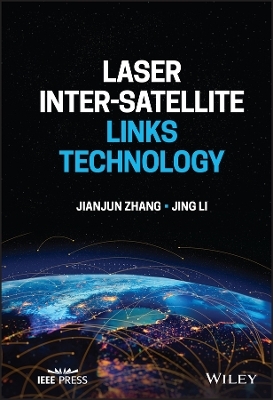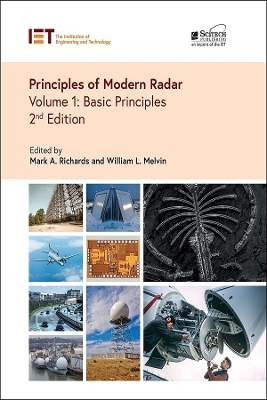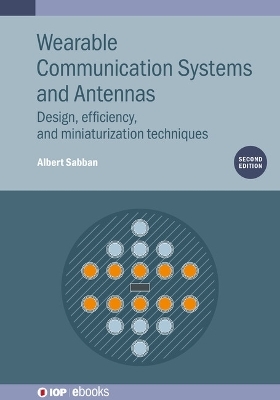
Laser Inter-Satellite Links Technology
Wiley-IEEE Press (Verlag)
978-1-119-91071-8 (ISBN)
Laser Inter-Satellite Links Technology explores satellite networking as a growing topic in the field of communication technology, introducing the definition, types, and working frequency bands of inter-satellite links, discussing the number of orbital elements of the spacecraft motion state under two-body motion and their conversion relationship, and establishing the basic demand model for inter-satellite link network, chain topology model, and transmission protocol model.
The book focuses on the analysis and introduction of the principles and error sources of microwave and laser inter-satellite ranging, including the basic composition, workflow, and constraints of the laser inter-satellite link, and related design principles of the inter-satellite laser transmitter and receivers. Later chapters also discuss theories and methods of acquisition, alignment, and tracking, the impact of alignment errors on performance, and inter-satellite link modulation and its implementation.
Specific sample topics covered in Laser Inter-Satellite Links Technology include:
Pulse position modulation (PPM), differential pulse position modulation (DPPM), digital pulse interval modulation (DPIM), and double-head pulse interval modulation (DH-PIM)
Basic demand model of inter-satellite link network application, including basic configuration of constellations and inter-satellite transmission networks
Inter-satellite ranging accuracy, principles of microwave inter-satellite ranging, and analysis of microwave ranging error sources
Effect of tracking error on the beam distribution at the receiving end and influence of tracking and pointing error on communication error rate
Laser Inter-Satellite Links Technology serves a completely comprehensive resource on the subject and is a must-have reference for experts and scholars in aerospace, along with graduates and senior undergraduates in related programs of study.
Jianjun Zhang, PhD, is a Professor at Beijing Institute of Spacecraft System Engineering, China Academy of Space Technology. He has published more than 50 SCI/EI search papers in international journals and conferences, authorized more than 20 invention patents at home and abroad, and published 3 monographs. Jing Li, PhD, is an Associate Professor at the School of Automation, Beijing Institute of Technology. She has presided over more than 10 projects at leading institutions.
Author Biography xi
Preface xiii
1 Introduction 1
1.1 Connotation of Inter-Satellite Link 1
1.2 Types of Inter-Satellite Links 5
1.3 Band Selection of Inter-Satellite Link 7
1.3.1 Selection of Link Band 7
1.3.2 Selection of Working Frequency 8
1.4 Microwave Inter-Satellite Link 10
1.4.1 Frequency Selection 10
1.4.2 Microwave Inter-Satellite Link Data Transmission System 12
1.5 Laser Inter-Satellite Link 14
1.5.1 Technical Characteristics of Laser Inter-Satellite Link 14
1.5.2 Future Requirements for Laser Inter-Satellite Links 15
1.5.3 Development Trend of Laser Inter-Satellite Links 16
1.5.3.1 The Development of Laser Communication Technology from Technical Verification to Engineering Application Stage 16
1.5.3.2 The Communication Rate Develops from Low Code Rate to High Code Rate 16
1.5.3.3 Deep Space Will Become an Important Place for Laser Communication Applications 17
1.5.3.4 Combined Use of Laser Communication and Laser Ranging 18
1.5.3.5 Integration and Miniaturization of Laser Communication Terminals 18
1.5.3.6 Networking of Laser Inter-Satellite Links 19
References 19
2 Development History of Laser Inter-Satellite Link 21
2.1 Development Stage of Laser Inter-Satellite Link 21
2.2 Development Status of Laser Inter-Satellite Link Technology in Various Countries 22
2.2.1 United States 22
2.2.1.1 Lunar Laser Communication Demonstration 26
2.2.1.2 Relay Laser Communication Demonstration (LCRD) (GEO-Ground) 27
2.2.1.3 Integrated Laser Communication Terminal (ILLUMA-T) 30
2.2.1.4 Deep Space Optical Communication (DSOC) Project Terminal Reaches Level 6 Technology Maturity 30
2.2.1.5 Ultra-Light and Small Communication Terminal (OSCD) 33
2.2.2 Europe 33
2.2.2.1 Semiconductor Laser Inter-Satellite Link Experiment 33
2.2.2.2 European Data Relay Satellite System Project (EDRS) 34
2.2.2.3 Micro Laser Communication Terminal (OPTEL-μ) 35
2.2.3 Japan 36
2.2.3.1 Japanese Data Relay Satellite 37
2.2.3.2 High-Speed Communication of Advanced Laser Instruments 38
2.2.3.3 Miniaturized Laser Communication Terminal (SOTA) 39
2.3 Experience and Inspiration 39
2.3.1 Strengthen the Research on New Laser Inter-Satellite Links and Enhance the Innovation of Technology Research and Development 40
2.3.2 Strengthen the On-Orbit Verification of New Technologies and Improve the Engineering Level of New Technologies 40
2.3.3 Simplify the Product Spectrum and Promote the Construction of Product Pipelines 40
2.3.4 Respond to Commercial Product Demand and Reduce Product Cost 41
2.3.5 The Key Development Direction of Low-Orbit Laser Inter-Satellite Link Engineering Demonstration Work 41
References 41
3 Spacecraft Orbits and Application 45
3.1 Overview 45
3.2 Kepler’s Laws 46
3.2.1 Kepler’s First Law 46
3.2.2 Kepler’s Second Law 47
3.2.3 Kepler’s Third Law 47
3.3 Two-Body Motion and Orbital Parameters 47
3.3.1 Two-Body Movement 47
3.3.2 Track Parameters 49
3.4 Near-Earth Space Orbits and Applications 53
3.4.1 Track Type 54
3.4.2 Sub-Satellite Point Trajectory 54
3.4.3 Several Commonly Used Tracks 55
3.4.3.1 Sun-Synchronous Orbit 55
3.4.3.2 Return to the Track 56
3.4.3.3 Geosynchronous Orbit 57
3.4.3.4 Freeze the Track 58
3.4.4 Overlay 59
3.4.4.1 Coverage Area 59
3.4.4.2 Minimum Observation Angle 60
References 61
4 Basic Model of Constellation Inter-Satellite Link Networking 63
4.1 Application Requirements of Satellite Navigation Inter-Satellite Links 63
4.1.1 Constellation Precise Orbit Determination and Time Synchronization 64
4.1.2 Data Communication 64
4.1.3 Autonomous Operation 65
4.1.4 Extended Service 65
4.2 Basic Requirement Model of Inter-Satellite Link Network Application 66
4.2.1 Basic Configuration of Constellations 66
4.2.2 Inter-Satellite Transmission Network Based on STDMA 67
4.2.3 Antenna Solution 71
4.2.4 Inter-Satellite Link Application Mode 72
4.3 Inter-Satellite Link Network Chain Topology Model 74
4.3.1 Analysis of Topological Attribute of Inter-Satellite Links 74
4.3.2 Inter-Satellite Visibility Analysis 74
4.3.3 Inter-Satellite Link Topology Cost 77
4.3.3.1 Path Loss 78
4.3.3.2 Transmission Loss 79
4.3.3.3 Protocol Overhead 82
4.4 Inter-Satellite Link Network Protocol Model 83
4.4.1 Inter-Satellite Network Protocol Model 83
4.4.2 Transport Layer Protocol 84
References 85
5 Principles of Laser Inter-Satellite Ranging 87
5.1 Principle of Inter-Satellite Ranging 87
5.2 Inter-Satellite Ranging Accuracy 88
5.3 Principle of Microwave Inter-Satellite Ranging 89
5.3.1 Principle of Pseudo-Range Two-Way Ranging 89
5.3.2 Analysis of Error Sources in Microwave Ranging 91
5.3.2.1 Antenna Phase Center Error 91
5.3.2.2 Device Circuit Delay Error 93
5.3.2.3 Multipath Effect Error 93
5.3.2.4 Ionospheric Delay Error 93
5.3.2.5 Relativistic Effect Error 94
5.4 Principle of Laser Inter-Satellite Ranging 95
5.4.1 Principle of Laser Pulse Ranging 95
5.4.2 Analysis of Error Sources in Laser Ranging 96
References 97
6 Composition of Laser Inter-Satellite Link 99
6.1 Basic Structure of Laser Inter-Satellite Link 99
6.1.1 Optical Transmitting Subsystem 99
6.1.2 Light Receiving Subsystem 100
6.1.3 Align, Capture, Track Subsystem (PAT) 101
6.2 Workflow of Laser Inter-Satellite Link 101
6.3 Constraints 103
6.3.1 Satellite Orbit 103
6.3.2 Satellite Attitude 104
6.3.3 Uncertain Angle of Pre-Cover 105
6.3.4 Satellite Vibration Problem 106
6.3.5 Dynamic Coupling Problem 107
6.3.6 Influence of Background Stray Light 107
6.4 Transmitter Design 110
6.4.1 Choice of Laser 110
6.4.2 Wavelength Selection 111
6.4.3 Selection of the Diameter of the Transmitting Antenna 112
6.4.4 Calculation of Transmitting Antenna Gain 112
6.5 Receiver Design 113
6.5.1 Selection of Receiver Detector 113
6.5.2 Selection of Receiving Antenna Aperture 114
6.5.3 Calculation of Receiving Antenna Gain 114
6.5.4 Calculation of Received Power 115
References 115
7 Inter-Satellite Laser Capture, Aiming, and Tracking System 117
7.1 Introduction 117
7.2 Acquisition 119
7.2.1 Capture Scheme 120
7.2.1.1 Stare-Scan 120
7.2.1.2 Scan-Scan 121
7.2.2 Capture Path 122
7.3 Pointing 123
7.4 Tracking 124
7.4.1 Analysis of Tracking System Beacon Beam Divergence 124
7.4.2 The Role of the Tracking System in the APT System 126
7.5 APT System Terminal Structure 128
7.5.1 Coarse Sight Subsystem Design 129
7.5.1.1 Coarse Sight Subsystem Composition 129
7.5.1.2 Coarse Aiming Control Subsystem Design 132
7.5.2 Design of Precision Sighting Subsystem 133
7.5.2.1 The Composition of the Precision Aiming Subsystem 133
7.5.2.2 Design of Precision Aiming Control System 135
References 136
8 Inter-Satellite Laser Link Tracking Error 139
8.1 Definition of Alignment Error 139
8.2 Alignment Error Model and Factor Analysis 140
8.2.1 Mathematical Modeling of Alignment Errors 140
8.2.2 Factors Causing Alignment Errors 143
8.2.3 Influence of Tracking Error on Beam Distribution at Receiver 144
8.2.3.1 The Effect of Tracking Error on the Beam Intensity at the Receiving End 145
8.2.3.2 Influence of Tracking Error on Beam Power at Receiver 146
8.2.4 Influence of Tracking and Pointing Error on Communication Error Rate 147
8.3 Analysis of Tracking and Pointing Error Sources of Inter-Satellite Laser Communication System 149
8.3.1 Satellite Platform Vibration 151
8.3.2 Detector Noise 152
8.3.2.1 Characteristics and Types of Detector Noise 152
8.3.2.2 Effect of Detector Noise on System Performance 155
8.4 Satellite Platform Vibration Suppression Scheme 157
8.4.1 Satellite Platform Vibration Suppression Scheme 157
8.4.1.1 Passive Vibration Isolation 157
8.4.1.2 Active Control 158
8.4.2 Feedforward Vibration Suppression Algorithm 159
8.4.2.1 Influence of Satellite Platform Vibration on Precision Aiming Control System 159
8.4.2.2 Analysis of Feedforward Vibration Suppression Algorithm 161
References 165
9 Inter-Satellite Link Laser Modulation Mode 167
9.1 Block Diagram of Inter-Satellite Link Optical Communication System 167
9.2 Typical Incoherent Optical Modulation (IM/DD) 168
9.2.1 On-Off Key Control 169
9.2.2 Pulse Position Modulation 169
9.2.3 Differential Pulse Position Modulation 169
9.2.4 Digital Pulse Interval Modulation 171
9.2.5 Double Head Pulse Interval Modulation 171
9.3 Coherent Optical Communication Modulator and Modulation Principle 172
9.3.1 Optical Modulator 173
9.3.2 Coherent Optical Communication Modulation Format 174
9.3.2.1 Binary Phase Shift Keying 174
9.3.2.2 Quaternary Phase Shift Keying 175
9.3.2.3 8psk 176
9.3.2.4 8qam 178
9.4 Comparison of Communication Performance of Laser Modulation Schemes 179
9.4.1 Average Transmit Power 179
9.4.1.1 OOK 179
9.4.1.2 PPM 179
9.4.1.3 DPPM 179
9.4.1.4 DPIM 180
9.4.1.5 DH-PIM 180
9.4.1.6 Coherent PSK 180
9.4.2 Transmission Bandwidth 180
9.4.2.1 PPM 180
9.4.2.2 DPPM 181
9.4.2.3 DPIM 181
9.4.2.4 DH-PIM 181
9.4.2.5 Coherent PSK 181
9.4.3 Bit Error Rate 181
9.4.3.1 OOK 182
9.4.3.2 PPM 182
9.4.3.3 DPPM 182
9.4.3.4 DPIM 183
9.4.3.5 DH-PIM 183
9.4.3.6 BPSK 183
9.4.4 Summary 183
References 184
Index 187
| Erscheinungsdatum | 22.12.2022 |
|---|---|
| Sprache | englisch |
| Gewicht | 866 g |
| Themenwelt | Technik ► Nachrichtentechnik |
| ISBN-10 | 1-119-91071-4 / 1119910714 |
| ISBN-13 | 978-1-119-91071-8 / 9781119910718 |
| Zustand | Neuware |
| Haben Sie eine Frage zum Produkt? |
aus dem Bereich


